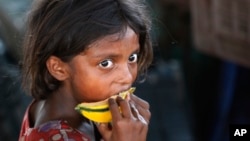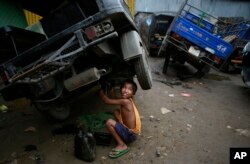The International Labor Organization is spearheading a global campaign to stamp out child labor, which victimizes 168 million children worldwide. To mark this year’s World Day Against Child Labor, a panel of experts focused on the abusive and widespread practice of child labor in international supply chains.
The “Choir for the Abolition of Child Labor,” a group of young musicians from Ivory Coast, spreads its message that children belong in school, not at work.
The pulsing beat of the music and the rap lyrics set the right note for the high-level panel discussion on ending child labor in supply chains. Under this system, children are employed all along the line from the manufacture of a product to its final distribution to the consumer.
It involves workers, small producers and enterprises around the world. Most child labor occurs in production for domestic markets, but children also produce goods and services for export. It mainly occurs in the rural and informal economy.
Joint effort needed
Director-General of the International Labor Organization Guy Ryder said the combined efforts of governments, employers, workers’ unions and consumers are needed to end this nefarious practice.
He said enterprises need to be vigilant to ensure their supply chains are free of child labor.
“From enterprises, we need a clear message of zero tolerance of child labor. They need to know what is happening in their supply chains and to back that up with action in their business practices and dealing with suppliers. And, this I believe is the common expectation of business in the 21st century,” said Ryder.
Children work for low or no pay in abusive, slave-like and dangerous conditions in agriculture, fishing, garment industries, electronics, manufacturing and in the mineral extractive sector.
Jacqueline Mugo is executive director of the Federation of Kenya Employers. She said employers worldwide are tackling the problem of child labor.
In some cases, she said employers will not hire children if the work is seen to cause hardships to the children or their families.
“In East Africa, we found that actually child labor was in many cases exacerbated by families that needed their income. And, so it is important to take this into consideration and there are programs that have been implemented to do this,” said Mugo.
But, Philip Jennings, general-secretary of UNI Global Union, a worldwide workers’ movement, said not enough is being done.
“It was Timothy Leary that said ‘tune in, turn on and drop out.’ There are 168 million reasons why we, as a community, cannot drop the ball and drop out of the conversation on child labor,” he said.
Jennings agreed progress is being made. He noted child labor has been cut by one-third in the last decade and governments have committed themselves to eliminating child labor by 2025.
“The clock is running. The time for excuses from business is over… We simply do not buy the argument that it is all the fault of government.We want business to accept its responsibility and to work with the social partners and local governments to ensure that child labor is not a reality,” he said.
Involving communities
Andrew Tagoe heads a program of rural and agricultural workers in Ghana. He described a community program, which intimately involves the inhabitants of Torkor — a small fishing village in Upper Volta — in tackling the problem of child labor.
“That is what we have called the Torkor model — that is bringing people on board to address their own child labor, to address their own deficit gap in terms of decent work… So, that community people in the village can sit with government and negotiate with government structures what they think they need as community people,” he said.
The panelists agree a key element in eradicating child labor is to provide decent jobs to adults and youth of working age. Some of the participants are calling on the ILO to enact a convention on supply chains that spells out the rules for ending child labor in this complex global system.











